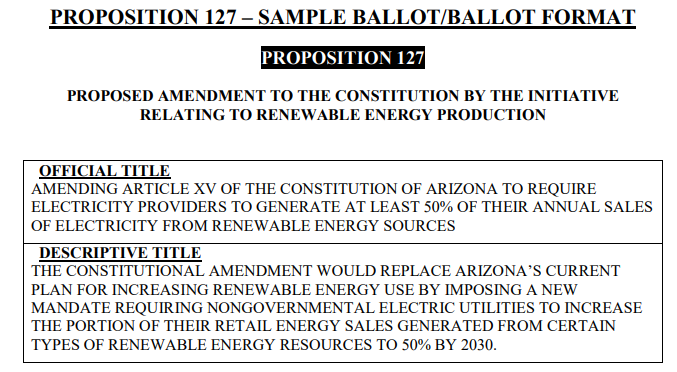
Proposition 127, also known as “Clean Energy for Healthy Arizona”, if passed will change the Arizona State Constitution to require electricity providers to generate at least 50% of their annual sales from specific kinds of renewable sources, specifically wind and solar.
First of all, let’s think about this. Do we really want to use the Constitution to manage energy policy? Think about how much energy and energy policy has changed over the past 50 years. And the changes in energy between 1918 and now is staggering. Is embedding today’s energy policy the best idea given the pace of technology?
I asked about the limitations to adopting new and better energy technology and updating energy policy when constitutional limitations are in place at the Secretary of State’s Town Hall meeting in Sun City West on October 20th. Bill Mundell was the pro Prop 127 speaker. He is an attorney and a former Arizona Corporation Commissioner. I didn’t really get a good answer. My concern of course is that the Corporation Commission will not have the latitude to update and approved new technologies and policy as time goes on. Mr. Mundell said the Commission would still be able to make these changes, but I reminded him of the mandates set in the Constitutional Amendment. To my knowledge, the State Constitution is always superior to the Commission and other government agency rulemaking. So, my concern stands.
When it comes to Prop 127 specifically, I am on the fence.
The name: A Constitutional Amendment Amending Article XV of the Constitution of Arizona to Require Electricity Providers to Generate at Least 50% of Their Annual Sales of Electricity from Renewable Energy Resources.
Long name and not too scary, until you realize that “goal” becomes a mandate by 2030 (11 years from now), only “certain types” of renewable energy count and 10% of energy generation must come from customer premises as of 2025. Of course, if private property owners choose not to pay for and install solar or wind technology, this opens the door to government mandated requirements like California just created.
The California Energy Commission passed a rule in May 2018 mandating that by 2020 new homes will have to have solar panels. That is an average price increase to a new home buyer of $9,500. So much for personal property rights, control over your personal finances, personal choice and affordable housing. The initial price of a home solar system is just the initial cost. What about maintenance, repairs and upkeep? What about replacing the inverter sometime around year 10 at an average cost of $3,000-$5,000? And again at year 20? The 50% renewable energy goal based on wind and solar is just not technologically available.
Last year APS presented at our WeMAR GAD event on solar. 30% seems like a reasonable and doable goal currently if your goal is to have reliable and affordable energy. Right now, there is no way to store solar or wind energy and that is the problem.
Think about your day. Do you and your neighbors use energy between 6am and 8am? And then do you ramp up your energy demand at home between 6pm and 8pm? So exactly how do you ramp up and ramp down wind and solar? California is finding out you don’t, so they are using diesel for their ramping up and ramping down needs according to the Institute for Energy Research.
Still not sure 50% or more wind and solar is too much or that it will impact you, your family and the economy? Look to Australia. Last summer Southern Australia didn’t have the ability to sustain electricity. Think about flipping the A/C on in August, but nothing happens. In fact, the Australian Parliament released a report outlining their concerns for Australia’s energy system. Of course, since Mr. Steyer owns the largest coal mine in South Australia, perhaps he will be providing coal to the Southern Australian energy system next summer?
What’s really interesting is the backer of Prop 127, Tom Steyer, had a parallel proposition in Michigan, 50% renewable by 2030. He cut a deal with utilities there for the amount to be 25% renewable energy by wind and solar by 2030 and he is happy.
I gotta ask, why is that a win? but Arizona who is already on track to have more than 30% renewable energy by 2025 needs Prop 127? Add to that Mr. Steyer made his fortune financing coal mines in Indonesia, South Australia and China, and his prolific use of energy tax credits; and the question of whether Prop 127 is good becomes a bit clouded.
I guess what I am really asking is, what is the plan? If we dismantle the existing energy system how do we mechanically transition over to a system that I haven’t found work yet?
Which brings me to the other consideration, California. In California the Public Utilities Commission, or PUC, released a report outlining their concerns for the California energy grid. Since the PUC is the regulator of energy in California, I think their concerns are worth noting.
Because of the dramatically increased renewable energy mandate that basically allows only wind and solar, California cities are forming their own energy utilities. Just like our prop 127, government owned/operated utilities are exempt from the regulation. Because cities hate when their residents and citizens call them to yell about no power or rolling blackouts, the cities have been forming their own utility companies. Now they can access power from any source they wish, in any amount. So, in the name of providing reliable, affordable power to their residents, cities are forming their own utility companies and providing power directly to city residents, also known as voters. I wonder if eventually California cities will be importing coal from one of Mr. Steyer’s coal mines in the Pacific Rim in order to provide the energy their residents and businesses need?
It is in fact a wholesale deregulation of the energy markets in California. The PUC report points out that there is no oversight or organization to this deregulation. The organization of new city owned energy companies is at the whim of each city, and because of that, the PUC is concerned for the overall structure of the California Grid. After all, if large numbers of public utility customers convert over to less expensive and more reliable city owned energy, then who will pay for the grid infrastructure? Who will the PUC regulate? What exactly is their job now?
And that is my dilemma. Do I vote “No” because I think Prop 127 will bring chaos to the system and bring us higher electric rates? Or do I vote “Yes” because I think Prop 127 will bring chaos to the system and lead to a deregulation of the energy markets and ultimately lead to better pricing and more freedom for local government utilities and their customers/voters to access energy sources as needed? Or will it lead to additional heavy handed and ill conceived government rules? Do I vote “No” because I am concerned that a dismantled system may lead to Arizona cities purchasing coal from China, thereby boosting China’s economic clout over the U.S. as they pursue their goals? Do I want to encourage Mr. Steyer to manipulate the energy system to his own personal ends and wealth?
And lastly, when I read Prop. 127 I see a strangling of human invention and creativity in finding and using energy in the future. Prop 127 is so stringent and limiting on the types of power allowed, that new forms of renewable energy are precluded. For instance, back east, there are energy companies who harvest energy from road vibrations. That sounds like something we can do, but Prop 127 in my reading would not allow that, unless the utility is government owned. Why?
I have faith that human ingenuity will bring us new and better ways to access the energy we need in cleaner and more efficient ways. Of course, as written, Prop 127 would allow government owned utilities to access these new technologies, but not private energy companies.
And so, my dilemma. Do I vote “yes” because my free market side wants the eventual outcome of deregulated and locally controlled energy markets? Or do I vote “No” because I think the dismantling of our system should be a more reasoned, and planned approach?
I encourage you to do your own research. Don’t just read the publicity pamphlet, do real research. Figure out if you are comfortable with this proposition. Or do we perhaps need a bit more conversation and planning in order to have affordable, sustainable, environmentally sound energy?

